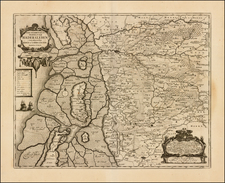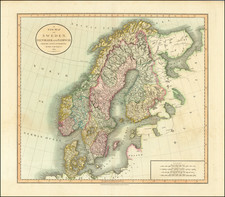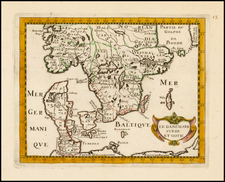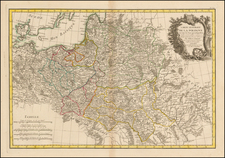Europae Tabula VIII is a significant map of Girolamo Ruscelli's oeuvre, published in Venice in 1561. It is a quintessential representation of Eastern European Ptolemaic cartography, harking back to the mapmaking traditions of Claudius Ptolemy, the ancient Alexandrine-Greek geographer.
The map's geographical focus encompasses a large swath of Northeastern Europe, spanning the realms of present-day Russia, the Baltic states, and Scandinavia. Notably, it brings to light several significant historical and geographical entities such as Sarmatia Europaea, Taurica Chersonesus, and Maeotidis Palus.
"Sarmatia Europaea" pertains to a vast region stretching from the Vistula River to the Ural Mountains, populated by the Sarmatians, an ancient Iranian people. "Taurica Chersonesus" refers to the Crimean Peninsula, a historically significant area coveted by numerous empires across time. "Maeotidis Palus" corresponds to the Sea of Azov, located off the northern shores of the Black Sea.
The map also showcases "Caesaris arae" and "Alexandri arae," two supposed monuments, one dedicated to Julius Caesar and the other to Alexander the Great. The "Hyperborei Montes," refer to a mountain range in the far north, aligning with the mythical Hyperboreans' location.
Also depicted are "Carpatus Mons," likely representing the Carpathian Mountains, "Daniae et Norvegiae Pars," a section of the Scandinavian Peninsula, and "Gothia Insula," modern-day Gotland.
Ruscelli's "Europae Tabula VIII" is indeed a compelling artifact, bridging the geographical conceptions of the ancient and early modern worlds. It is not only a mirror reflecting the cartographic knowledge of its time but also a vibrant testimony to the enduring influence of Ptolemaic geography.
Girolamo Ruscelli (1500-1566) was a cartographer, humanist, and scholar from Tuscany. Ruscelli was a prominent writer and editor in his time, writing about a wide variety of topics including the works of Giovanni Boccaccio and Francesco Petrarch, Italian language, Italian poetry, medicine, alchemy, and militia. One of his most notable works was a translation of Ptolemy’s Geographia which was published posthumously.
There is limited information available about Ruscelli’s life. He was born in the Tuscan city of Viterbo to a family of modest means. He was educated at the University of Padua and moved between Rome and Naples until 1548, when he moved to Naples to work in a publishing house as a writer and proofreader. He remained in the city until his death in 1566.









![Polonia Secondo le Osservazioni dell' Accademia di Parigi [Poland, according to the observations of the Paris Academy.]](https://storage.googleapis.com/raremaps/img/small/67787.jpg)



![[The Russian Question] Die Russische Frage. Ein Schauspiel von K. Simonow](https://storage.googleapis.com/raremaps/img/small/83978.jpg)
